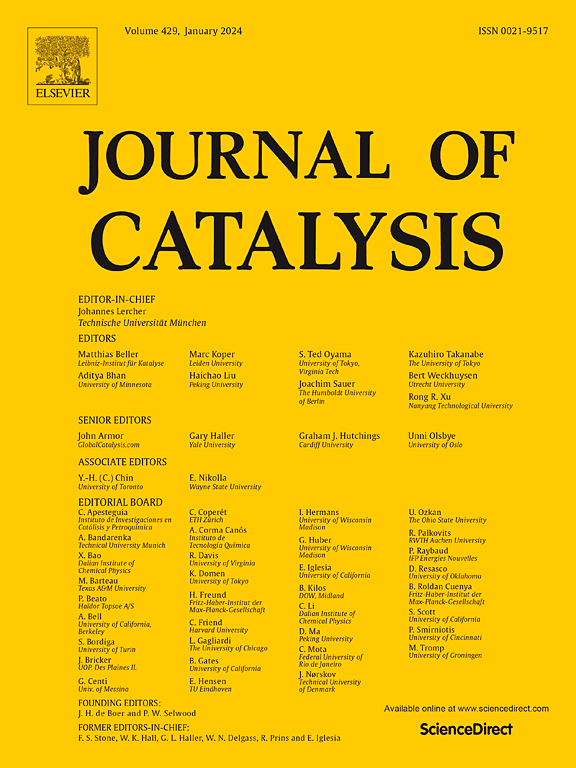Electrochemical CO2 reduction by Mn-mesbpy complex: Tuning redox properties and mechanistic switching via ligand substitution
IF 6.5
1区 化学
Q2 CHEMISTRY, PHYSICAL
引用次数: 0
Abstract
Density functional theory (DFT) calculations were used to investigate the effects of electron-donating and electron-withdrawing substituents on the mesbpy ligand of Mn-based complexes employed in the electrochemical reduction of CO2. The influence of these substituents on reduction potentials, CO2 binding affinities, and the overall catalytic mechanism was systematically examined. DFT results indicated that Mn complexes bearing electron-donating groups (–CH3, –OH), neutral groups (–H), and moderately electron-withdrawing groups (–F) can bind CO2 in the two-electron-reduced state. In contrast, Mn complexes with strongly electron-withdrawing substituents (–CF3, –CN) facilitate the initial reduction step but fail to bind CO2 at the same redox state, thus requiring a third electron for activation. However, these complexes become energetically inefficient as catalysts due to the high energy demand associated with the three-electron reduction. The mechanistic insights presented here, which distinguish Mn complexes bearing electron-donating or moderately electron-withdrawing substituents from those with strongly electron-withdrawing groups, provide valuable design principles for the development of energy-efficient Mn-based CO2 reduction catalysts.


Mn-mesbpy配合物的电化学CO2还原:通过配体取代调节氧化还原性质和机制切换
采用密度泛函理论(DFT)计算研究了供电子取代基和吸电子取代基对锰基配合物网状配体在CO2电化学还原中的影响。系统地考察了这些取代基对还原电位、CO2结合亲和力和整体催化机理的影响。DFT结果表明,具有供电子基团(-CH3, -OH)、中性基团(-H)和适度吸电子基团(-F)的Mn配合物能以双电子还原态与CO2结合。相比之下,具有强吸电子取代基(-CF3, -CN)的Mn配合物有助于初始还原步骤,但不能在相同的氧化还原状态下与CO2结合,因此需要第三个电子来激活。然而,由于与三电子还原相关的高能量需求,这些配合物作为催化剂变得能量效率低下。本文提出的机制见解区分了具有供电子或适度吸电子取代基的Mn配合物与具有强吸电子基的Mn配合物,为开发节能的Mn基CO2还原催化剂提供了有价值的设计原则
本文章由计算机程序翻译,如有差异,请以英文原文为准。
求助全文
约1分钟内获得全文
求助全文
来源期刊

Journal of Catalysis
工程技术-工程:化工
CiteScore
12.30
自引率
5.50%
发文量
447
审稿时长
31 days
期刊介绍:
The Journal of Catalysis publishes scholarly articles on both heterogeneous and homogeneous catalysis, covering a wide range of chemical transformations. These include various types of catalysis, such as those mediated by photons, plasmons, and electrons. The focus of the studies is to understand the relationship between catalytic function and the underlying chemical properties of surfaces and metal complexes.
The articles in the journal offer innovative concepts and explore the synthesis and kinetics of inorganic solids and homogeneous complexes. Furthermore, they discuss spectroscopic techniques for characterizing catalysts, investigate the interaction of probes and reacting species with catalysts, and employ theoretical methods.
The research presented in the journal should have direct relevance to the field of catalytic processes, addressing either fundamental aspects or applications of catalysis.
 求助内容:
求助内容: 应助结果提醒方式:
应助结果提醒方式:


